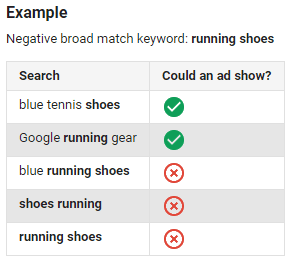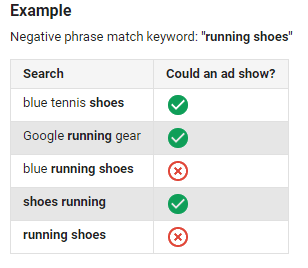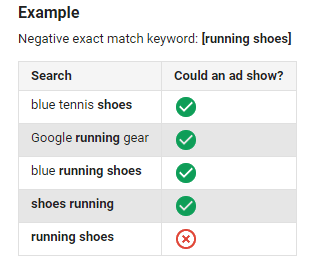Navigating the World of Negative Keywords in Search Engine Marketing

Welcome to our comprehensive guide on “Navigating the World of Negative Keywords in SEM.” Search Engine Marketing (SEM) is a powerful tool for driving targeted traffic to your website. Still, with a proper understanding of negative keywords, you may save valuable resources and avoid losing potential customers. In this blog, we will demystify the concept of negative keywords and show you how to wield them skillfully to enhance your SEM campaigns. Whether you’re new to SEM or a seasoned marketer looking to optimize your strategies, this article will equip you with the knowledge and tactics needed to take control of your ad spend, boost click-through rates, and, ultimately, drive greater success in the world of SEM. Let’s dive in and explore the art of using negative keywords to your advantage!
What Are Negative Keywords?
Negative keywords prevent individuals who look for or read content containing those words from seeing your advertisement.
To continually increase relevance and, thus, ROI, effective paid search management entails extending the keywords you’re bidding on while optimizing the ones you’re already bidding on. The second part also includes removing some search queries and halting underwhelming performance.
You may accomplish this using negative keywords, ensuring that only the most qualified prospects see your adverts.
Negative keywords are available in broad, phrase, and specific varieties, much like the keywords you bid on, and can be assigned at the account, campaign, or ad group level. You must fully understand how these match types operate to get the most out of negative keywords in your Google Ads and Bing ad accounts.
Negative keyword match types
If you use negative broad match, your keywords are matched to numerous permutations of a phrase, not all of which will be obvious extensions of the phrase you’re targeting or relevant to your business.
In the example below, even if the words aren’t spelled the same way, the negative broad match keyword running shoes would block any queries that display the whole negative keyword.

Your ads will still be allowed to participate in auctions even if they contain some (but not all) of the terms in your negative keyword. Thus, you will still appear in relevant search results. This is demonstrated by the example given above, where ads would still be presented in response to searches for “blue tennis shoes” and “Google running gear.”
Negative phrase match keywords are slightly less restrictive.
Any search that doesn’t include “running shoes” would be eligible to see your advertising. This is because this iteration only rejects search terms that exactly match the phrase you entered. Your budget is secure if the search query contains the precise phrase you’ve selected, even if it comprises more words than your negative phrase matches the keyword.

You can eliminate certain search queries by using negative exact-match keywords. Your advertisements won’t only appear when a searcher types in what you’ve added if you add negative exact match keywords to your Google advertisements account.

The Display Network and YouTube (TrueView campaigns) have slightly different rules; all negative keywords are regarded as exact matches in these ads.
Adding too many negative keywords will hinder your capacity to contact prospects, regardless of your advertising network. On the other hand, a correctly chosen list can help you save a tonne of money.
More advantages to adding negative keywords
Increased Click-Through Rate (CTR) – By ensuring that your advertisements aren’t appearing for irrelevant searches, you’ll expose your account to fewer uninterested impressions, resulting in more individuals clicking on your ad.
Create More Relevant Ad Groups – You may tighten the relevancy of your ad groups by eliminating terms that aren’t pertinent to your company. You can create a single message that communicates to the full collection of keywords by using small, closely linked ad groups.
It’s wonderful that it’s listed twice: Save Money (Again). You save a lot of money by eliminating searchers who need to be a better fit for your business by avoiding paying for pointless clicks. Additionally, you may prevent bidding against yourself, consuming your impressions, and diluting keyword-level data.
Increase Your Conversion Rate – Negative keywords will ensure that your advertisements don’t appear for specific terms you know won’t convert, including the names of rival companies or ones that express a complete lack of commercial intent.
How to Add Negative Keywords
Let’s say you wish to use phrase-match and broad keywords in your account to boost traffic. Then, it would be best to think critically about avoiding pointless clicks and impressions while keeping an eye on your advertising budget.
Negative keyword discovery has been difficult, requiring time spent brainstorming (with little success) or painstakingly reviewing search query reports in Google Ads.
Go to the “Keywords” tab in the Google Ads UI, whether at the account, campaign, or ad group level, to begin this journey:
You may view the keywords you’re bidding on here by default but not the precise queries that brought them up. For access, select “Search Terms” from the same menu.
The next step is to add a negative term to your Google Ads account. Check the box to the left of the search query (as shown above) if you encounter a search term that you want to avoid your advertisements being with. A blue option bar will appear after this action:
Choose “Add as negative keyword” since you want to add this query as a negative term (yeah, it’s that easy). You will then be given the option to select the desired match type and the level at which the negative keyword should be allocated.
When you save your modifications after selecting, your negative keyword will go into effect!
If you wish to apply your negative keyword to a negative keyword list and use it across multiple areas within your account, you can do so easily.
Also read: Role of Web Design in User Experience
Advanced (Negative) Search Query Mining
If your only concern is bidding on broad-match keywords to increase impression volume without considering your search queries, you’re squandering your money. Neglecting your search queries and failing to manage negative keywords effectively can cause you to miss expensive search inquiries that may have a detrimental influence on your capacity to turn potential searchers into paying clients.
Adding negative keywords to your Google Ads account was previously explored. Let’s now figure out which search terms need to be negated.
In contrast to search queries, which are merely suppositions, keywords are actual user actions. When using a search engine, you assume your potential consumers will utilize keywords, but search queries show the actual words and phrases used. A single keyword can often match numerous search queries.
Inexperienced or overworked account managers may use qualitative approaches to find the best negative keyword chances at scale. This approach entails alphabetizing the list of search terms and assessing each line individually by asking, “Does this have anything to do with my business?” Although this method can assist in removing pointless questions, it can be extremely wasteful, especially at scale, and it doesn’t fully utilize the quantitative data that is already accessible.
A more effective approach involves asking three key questions to determine whether a search query should be transformed into a negative keyword or added to a list of negative keywords:
- Does this search query have a below-average click-through rate (CTR)?
- Does this search query have a below-average conversion rate?
- Does this search query have an above-average cost per conversion?
Conclusion
Understanding and utilizing negative keywords in your SEM campaigns is an indispensable skill for digital marketers. These keywords can optimize ad targeting, save valuable resources, and improve effectiveness. Stay vigilant in monitoring performance, adapt your strategies, and watch your SEM endeavors thrive. Happy navigating through the world of negative keywords!
FAQs
What are negative keywords in Search Engine Marketing (SEM)?
Negative keywords are specific terms or phrases you add to your SEM campaign to prevent your ads from appearing when users search for those terms. Using negative keywords strategically lets you filter out irrelevant search queries, ensuring your ads are displayed only to the most relevant and qualified audience. This improves your SEM campaigns’ overall efficiency and effectiveness.
How do I identify the right negative keywords for my SEM campaigns?
Identifying the right negative keywords requires thoroughly understanding your target audience and their search intent. Start by analyzing search query reports and identifying search terms that trigger your ads but are irrelevant to your offerings. Additionally, conduct keyword research to uncover potential negative keywords that overlap with your primary keywords but don’t align with your campaign goals. Continuously refine your negative keyword list based on ongoing data analysis and customer feedback to ensure optimal campaign performance.
Can negative keywords impact my ad budget and ROI (ROI)?
Absolutely! Incorporating negative keywords can significantly impact your ad budget and ROI. By preventing your ads from displaying for irrelevant searches, you can reduce unnecessary clicks and impressions, ultimately saving on ad spend. This enables you to allocate your budget more efficiently, focusing on high-performing keywords and attracting a more qualified audience, thus increasing your chances of conversions and improving your ROI.
Do negative keywords affect my Quality Score and Ad Rank in Google Ads?
Negative keywords can influence your Quality Score and Ad Rank in Google Ads. When you use relevant negative keywords, you enhance the relevance and quality of your ad campaigns. A higher Quality Score improves your ad’s visibility and reduces your cost per click, potentially giving you an advantage over competitors. By optimizing your Ad Rank, you can achieve better ad placements and attract more clicks from interested users, further contributing to the success of your SEM efforts. Regularly monitor and adjust your negative keyword list to maintain a positive impact on your ad’s performance metrics.

Comments are closed